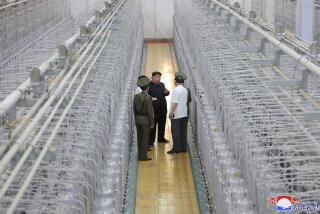Soviets Push to Double Nuclear Energy Capacity
- Share via
MOSCOW — For more than a decade, Soviet nuclear energy has been lagging behind expectations, plagued by construction problems that have thwarted Moscow’s grandiose ambitions.
Now central planners again want to more than double nuclear capacity in the next five years, and again the industry is gearing up for a major push.
“We are even awed ourselves,” said Genadi Veretennikov, chief of the Soviet nuclear energy administration in the Ministry of Power and Electrification.
Nuclear energy takes on an even more urgent role as the Soviet Union copes with a drop in its oil production.
The shortfall in the oil fields, compounded by the plunge in oil prices, threatens to cut into foreign earnings and only accelerates the need to switch from oil to other forms of energy.
The push to build more nuclear power plants has been under way for the last 10 years. With 15 plants now in existence, the Soviet Union has more nuclear reactors in operation than any country except the United States and France.
Construction Woes
But major construction problems--particularly at the giant Atommash facility in Volgodonsk--have stalled plans, Soviet officials readily admit.
Atommash, a reactor-manufacturing plant on the Don River, originally was supposed to produce four complete sets of reactors by last year.
Instead, the factory produced “about two” in 1985 and is expected to produce “no less than three” in 1986, according to the power and electrification ministry last month.
The slowdown in construction at Atommash, which produces 1,000 megawatts and is the mainstay of Soviet plants, stems from one of the most costly and embarrassing blunders in recent Soviet history.
Sinking Facility
Situated on the edge of a man-made lake, the factory’s foundation began to sink, imperiling an investment calculated at $4 billion.
After a special investigation by the Politburo in the summer of 1983, an emergency rescue operation was launched, and apparently the factory now is functioning.
The calamity at Atommash and other construction problems--problems of cost, standardization and labor--were the main causes for the setback in the nuclear expansion timetable that Veretennikov had estimated at one year.
The last five-year plan had pledged to boost nuclear-energy capacity to 32 million kilowatts. At the end of last year the program was 4 million short of the goal, equal to the capacity put on line in 1985.
“We are lagging behind by one year, like students who are behind in studying for their exams,” Veretennikov said in an interview.
Staggering Goal
In the 12th five-year plan beginning next year target figures call for an addition of 40 million kilowatt capacity to the system, Veretinnikov said. Considering that in the last 30 years the Soviet Union created 28 million kilowatts, the goal is staggering.
The latest goal for the nuclear industry calls for a jump from 170 billion kilowatt hours in 1985 to 370 billion to 380 billion by 1990.
Nuclear energy, now 9% of energy production, will become 19% by 1990 and 30% by the year 2000, according to Veretennikov. In the European part of the Soviet Union, nuclear energy will become the principal source of electricity--55% to 60%--by 2000.
The subject of nuclear energy came up recently on a program that now appears regularly on Soviet television, called “Problems, Issues and Answers,” on which government officials answer questions from viewers.
Anatoly Mayorets, minister of power and electrification, acknowledged the enormity of the task set for the nuclear industry and the need for heroic efforts to meet it.
“Of course that is no easy program, and a great deal of effort will be required from power engineers, machine builders, instrument builders and from the national economy as a whole to realize this immense program,” Mayorets said.
Nuclear Benefits Cited
Mayorets touted nuclear power stations as being cheaper than thermal ones and close to the cost of hydroelectric stations.
In answer to a question on safety, Mayorets said that “unequivocally,” nuclear energy is “ecologically the purest source of electricity” in terms of working conditions and local impact.
Nuclear reactors in the Soviet Union frequently are built right next to population centers, and although there is occasionally a hint of public concern--as in the case of the viewer’s question--the question of safety never has held back Soviet nuclear planning.
In Novovoronezh, a town of 32,000 outside Voronezh in central Russia, yet another reactor is planned at a station that already has five units.
The Voronezh plant represents three generations of Soviet nuclear power, each using a different cooling system.
The most recent, with a capacity of 1,000 megawatts, is served by a water from a man-made pool, used as a recreational lake by the local population.
Standardization Pushed
Now, the push in the Soviet nuclear energy program is toward standardization-an assembly-line approach to commissioning new reactors that saves time and labor, Veretennikov said.
The model is at Zaporozhye Atomic Station in the Ukraine, where the construction of units has been staggered over five years. To fulfill the plan, new building will go on at 20 sites--some new, some old, Veretennikov said.
Veretennikov said that bigger reactors of 1,500 megawatts will be built increasingly, although the 1,000 megawatt reactor will remain the basic unit.
The Soviet Union also is “actively examining” broader use of breeder reactors, Veretennikov said.
But, Veretennikov said, the key to fulfilling the program this time is not technology, but construction.
A new program to train personnel in assembling and operating nuclear plants has begun at Voronezh, answering the need for better skilled labor in the field, Veretennikov said.
“The most important need is to shorten the time spent on construction, which in its turn will improve other problems,” he said.
More to Read
Sign up for Essential California
The most important California stories and recommendations in your inbox every morning.
You may occasionally receive promotional content from the Los Angeles Times.













